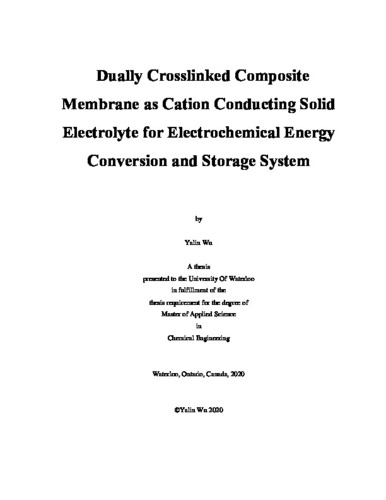| dc.description.abstract | Ion exchange membrane (IEM) is a key component of redox flow batteries (RFB) that heavily influences the electrochemical performances, energy efficiency and long term stability of the system. Ionic conductivity, ionic selectivity, chemical stability and cost effectiveness are four major parameters commonly adapt to evaluate and identify suitable candidate for applications in RFB. To achieve the optimal balance of these parameters, recent research and development try to be effective in tuning structural porosity, composition functionality, membrane selectivity, and ionic conductivity. Particularly, the sulfonated polyether ether ketone (SPEEK) based membrane was identified to process high ion selectivity and easy scale preparation, while PVA has been discovered as a decent transporting media for cation solid electrolyte.
Building on the discoveries of previous researches, this thesis aims to identify an optimal recipe and process to prepare the cation exchange membrane for applications in redox flow batteries. Matrix content and cross-linking agent are first systematically evaluated to lay a solid ground work for developing a membrane with good stability, easy forming as well as cost-effectiveness. Then, cross linking environment with different catalysts are investigated to optimize the process for crosslinking with PVA and building networks internal of the membrane to improve its stability. The condition of the physical cross-linking process are also compared to achieve ideal maturation of the membrane necessary to achieve sufficient chemical and physical stability. Additionally, the incorporation of GO was explored with the goal to utilize its special 2-dimensional nano structure for enhancing the stability and improving the ionic conductivity of the composite membrane.
As a result of the above series of experiments, PVA/PSSA/1 wt% GO are identified with the solution casting method. The 10 wt% poly (ethylene glycol) dimethyl ether (PEGDE) displays its advantage in setting-up networks internal of the membrane with the help of ethylenediamine as the reaction catalyst. The 2h, 100°C physical cross-linking follows the chemical cross-linking step further improving the membrane stability and finally get the PVA/PSSA/1 wt% GO composite membrane demonstrates 33.3% of dimensional stability, 74.6 % of water up-take, and 0.91 S/cm of ionic conductivity, which is a good candidate for the redox flow battery. | en |

